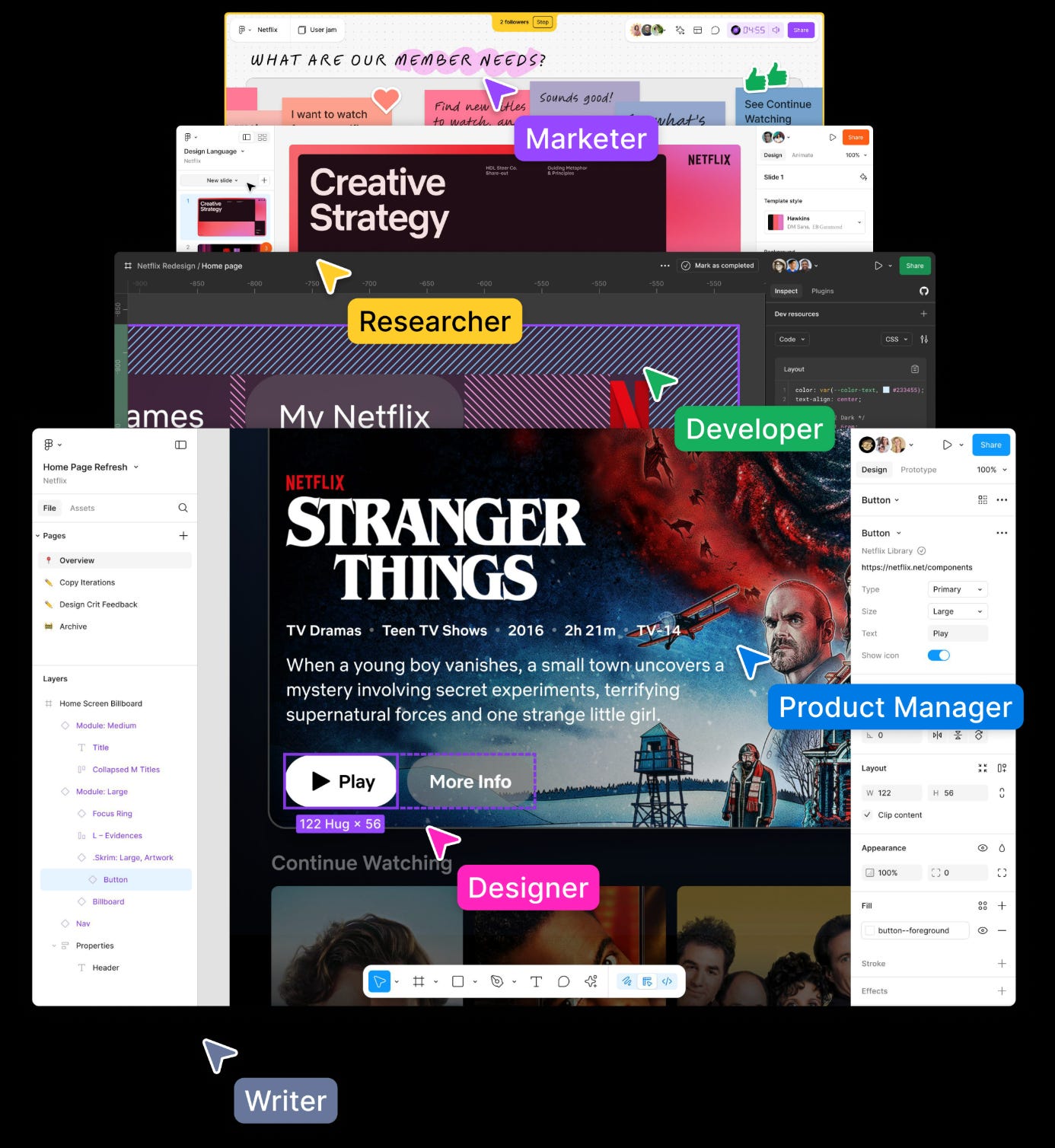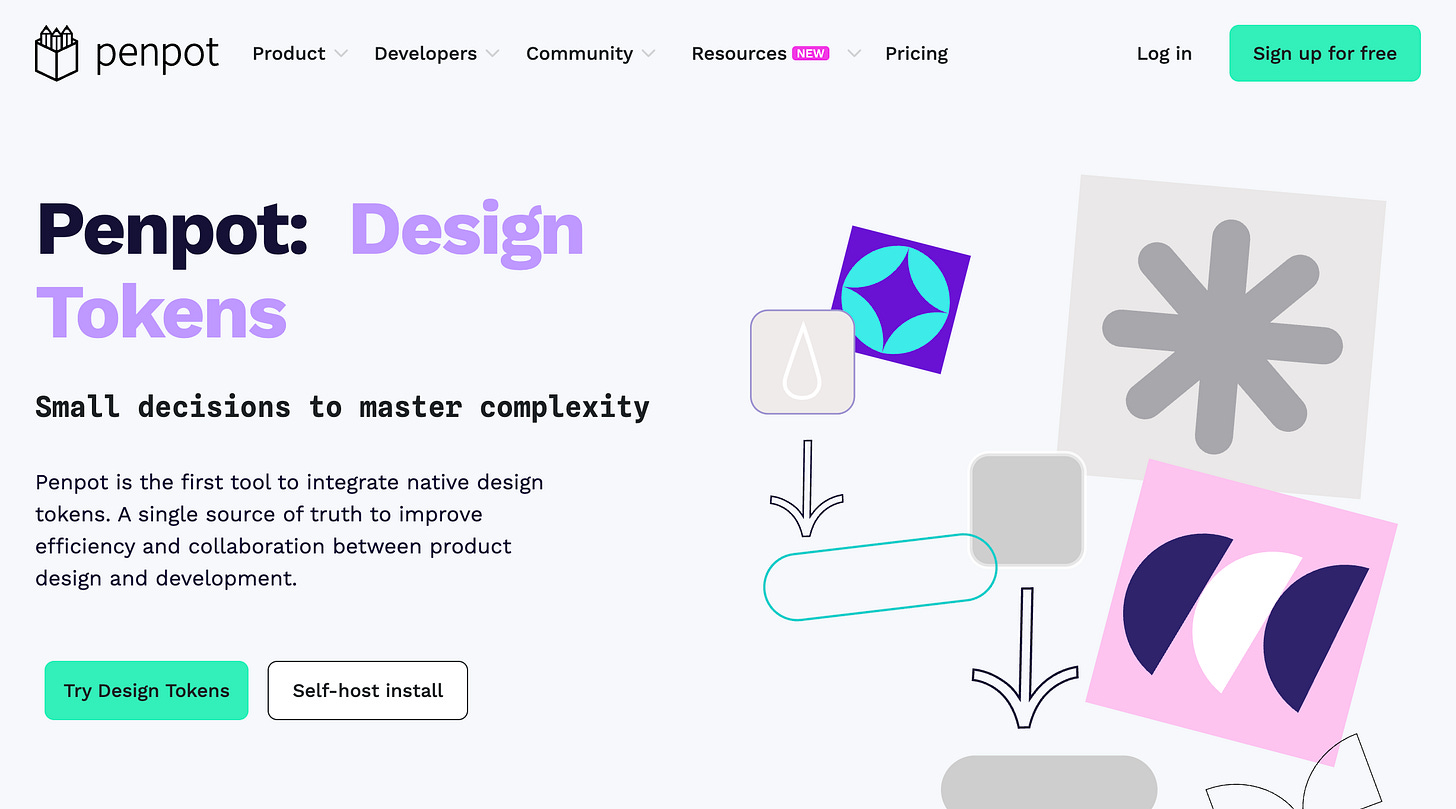Figma’s IPO Is a Wake-Up Call
#008: Inside Figma's shift from product to platform, and how its rent-seeking business model threatens to handcuff designers and the organizations they support.
When Figma filed its IPO paperwork with the SEC last week, it confirmed what many of us had long suspected: the company isn’t pretending to be just for designers anymore. It’s building the operating system for digital product teams. Files, comments, design systems, versioning, tokens, site publishing, developer handoff, and AI-assisted ideation are all being brought under one roof, on top of one common platform.
It’s a smart business move and, on the surface, it’s great for teams who crave speed and simplicity. But the more I sit with the implications of Figma’s IPO, the more uneasy I become.
Figma’s IPO materials send a clear message: “We are the new creative infrastructure. We are the layer between every product team and their output. We are indispensable.”
The week of Config 2025 only reinforced this realization. While many attendees focused on the new features — Dev Mode enhancements, better variables, more AI —the real story was strategic consolidation. Figma is moving fast to turn its tool into the platform, and its platform into a rent-seeking layer that captures value from every part of the design, development, and now marketing workflow.
This isn’t about why Figma itself is good or bad. It’s about understanding what happens when creative infrastructure becomes privatized, and imagining what a healthier, more open alternative might look like.
The Rise of Rent-Seeking Platforms
Figma’s behavior fits neatly into a well-worn Big Tech playbook. First, offer incredible utility and convenience to generate dependency. Then, once switching costs are high enough, extract value — not through innovation or productivity, but through control. (Banks also work like this, by the way.)
Take FigJam, Dev Mode, and Variables. Each was launched with glowing fanfare and made free at first. But the fine print always included a familiar phrase: “free until [date], then available on paid plans.” These aren’t trials in the traditional sense. They’re strategic wedges, designed to encourage teams to rebuild key workflows inside Figma before usage fees kick in.
And the fees are per seat. For design teams with complex cross-functional needs, that adds up fast.

This is how platform lock-in evolves into platform rent. Figma isn’t just enabling collaboration; they’re gradually positioning themselves as the toll booth for every major design-adjacent activity.
This mirrors what we’ve already seen with other dominant platforms:
Google gave away search, Gmail, and Docs for free — until entire businesses ran on them. Now, it reshapes the web to suit its ad business and charges enterprises to access capabilities that were once open.
Facebook built a global social graph, then slowly throttled reach and charged creators and brands to speak to the very audiences they built themselves.
Apple built an App Store that enables innovation—but taxes every transaction at 30% and controls which apps can even exist.
In each case, the platform became essential infrastructure. And once that status was secured, the incentives shifted. Growth came not from enabling users, but from monetizing their dependence.
This is the natural endpoint of centralized infrastructure. And it’s where design is heading if we don’t rethink the stack.
What Could a Federated Future Look Like?
Inspired by decentralized social networks like Mastodon and Bluesky, a federated design infrastructure would reject the all-in-one monoculture. Instead of one company owning the entire stack, design tools, components, and collaboration protocols could be interoperable, distributed, and portable.
In this model:
Design tokens live in open formats like the W3C community spec, used by any number of tools.
Component libraries are published to registries like Bit.dev or OpenComponents, with governance handled internally or by open communities.
Design and prototyping tools — open source or commercial — plug into this infrastructure using shared APIs and protocols.
Versioning, feedback, and handoff are layered services, not owned by the tool itself.
Teams could still move fast and scale, but without the threat of being held hostage by a single dominant platform owner.
Why It’s Hard — and Why It’s Worth It
Decentralization sounds great on paper. But if we’re honest, most open design tooling today lags behind in polish, adoption, and community investment seen in Figma. Tools like Penpot and UXBOX are promising, but they’re not (yet) enterprise-grade.

Still, the value isn’t just in tool parity — it’s in agency. A federated model would:
Let teams host their own libraries and assets
Encourage modular innovation instead of monolithic bloat
Prevent rent-seeking behavior from dominant vendors
Enable collaboration across organizations, not just within them
Reduce risk when vendors pivot, IPO, or get acquired
But to build that future, we also need to learn from others who tried.
What Blockchain Got Wrong
If you’ve been following web3 over the past few years, you might notice familiar language here: decentralization, protocols, interoperability, user control. In many ways, the blockchain ecosystem tried to build exactly this—but for finance, identity, and community infrastructure.
And yet, the results have been... mixed at best.
Rather than delivering a cohesive alternative to centralized platforms, the blockchain world became a fragmented, usability-poor, hype-driven landscape dominated by venture capital, pump-and-dump scams, and predatory incentives. Governance systems like DAOs turned out to be either ineffective or dominated by early insiders. Most users still rely on centralized exchanges and custodial wallets, despite the rhetoric of decentralization.
Even as protocols like Ethereum promised openness, a handful of companies still captured the majority of market power—and with it, the ability to steer the ecosystem’s values.
The answer isn’t blockchain-for-design — it’s learning from what blockchain taught us: that decentralization is easy to talk about, hard to do well, and not inherently virtuous unless the systems and incentives around it are built with care.
Design can’t afford to repeat these mistakes.
If we want federated infrastructure, we’ll need not just open protocols, but usable tools. Not just ideology, but shared governance. Not just modularity, but thoughtful coordination. The answer isn’t blockchain-for-design — it’s learning from what blockchain taught us: that decentralization is easy to talk about, hard to do well, and not inherently virtuous unless the systems and incentives around it are built with care.
So What Now?
This isn’t a call to drop Figma. It’s a call to ask better questions about the infrastructure we’re building our creative work on.
If you're responsible for a design system, ask:
Are our design tokens portable outside of Figma?
Is our component documentation locked in a proprietary format?
Could we switch platforms if pricing or priorities changed?
Are we contributing to shared standards, or just reinforcing vendor dependencies?
If you’re a toolmaker or startup founder, consider:
Could you build on open token formats, instead of inventing your own?
Could your tool act more like a plugin to a federated system, instead of a closed suite?
Could you partner with others to form the beginnings of a decentralized design protocol?
And if you’re just a curious designer: imagine what it would mean to co-create your design tools, not just use them.
Because infrastructure is strategy. And the future of design will be shaped not just by what we create but by how, and with whom, we choose to build the systems that support it.



